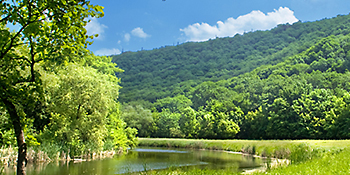Environment and Natural Resources
The Department of Environment and Natural Resources (Filipino: Kagawaran ng Kapaligiran at Likas na Yaman, DENR or KKLY) is the executive department of the Philippine government responsible for governing and supervising the exploration, development, utilization, and conservation of the country’s natural resources.
History
The Department of Environment and Natural Resources was first established on January 1, 1917 as the Department of Agriculture and Natural Resources (DANR) through the enactment of Act No. 2666 by the Philippine Commission, otherwise known as “An Act to Re-organize the Executive Department of the Government of the Philippine Islands,” on 18 November 1916. In 1932, the DANR was reorganized into the Department of Agriculture and Commerce (DAC).
In 1947, a reorganization act changed the DAC back to the Department of Agriculture and Natural Resources. The Natural Resources arm of the DANR was finally spun off on May 17, 1974 as the Ministry of Natural Resources. On January 30, 1987, the Ministry was reorganized into the Department of Environment, Energy and Natural Resources, by Executive Order No. 131 and was finally reorganized into the Department of Environment and Natural Resources by Executive Order No. 192 on June 10, 1987. Currently, the DENR is working on a large-scale reforestation of Davao City.
Bureaus
| Bureau | Acronym | Filipino Name | Incumbent |
|---|---|---|---|
| Environmental Management Bureau | EMB – DENR | Kawanihan ng Pamamahalang Pangkapaligiran | Engr. Metodio Turbella [3] |
| Mines and Geosciences Bureau | MGB- DENR | Kawanihan ng Pagmimina at Agham-Panlupa | Mario Luis Jacinto[4] |
| Forest Management Bureau | FMB | Kawanihan ng Pamamahala sa mga Kagubatan | Nonito Tamayo |
| Biodiversity Management Bureau (formerly Protected Areas and Wildlife Management Bureau) | BMB (formerly PAWB) | Kawanihan ng Pamamahala sa Sari-Saring Buhay (formerly Kawanihan ng Pamamahala sa mga Parke at Buhay Ilang | Dr. Theresa Mundita Lim |
| Land Management Bureau | LMB | Kawanihan ng Pamamahala sa mga Lupa | Atty. Emelyne V. Talabis (Acting Director) |
| Ecosystems Research and Development Bureau | ERDB | Kawanihan ng Pananaliksik at Pag-unlad Pangkalikasan | Dr. Henry Adornado |
Directory of Key Officials
| GRACE B. GRAVOSO | OIC PENRO, Western Samar | Brgy. Guidapuan, Catbalogan, Samar (055) 543-8122 | ||
| BALDOMERO U. NUÑEZ | CENRO, Sta Rita | Brgy. San Juan, Sta Rita, Samar; 0917-3059806 | ||
| JOSELITO L. ECO | OIC CENRO, Catbalogan Samar | Brgy. Poblacion, Catbalogan, Samar; (055) 543-8857 | ||
Protecting Natural Resources
- Water
Adequate water supplies of high quality are necessary both for community use and local ecosystems. Communities and jurisdictions must work together to assure an adequate water supply to meet future needs. This section presents resources to aid in that effort. - Energy
Communities require energy. Nonrenewable sources for power generation, home and workplace, and transportation cause pollution and its harmful impacts. Energy conservation and the use of renewable fuels provide cost-effective and more sustainable alternatives. This section contains resources available to make energy use more efficient. - Air and Climate
Both the natural ecosystem and human health can be adversely impacted by declining air quality and climatic change. Communities can preserve air quality by limiting or eliminating the discharge of harmful chemicals into the air and by minimizing the sources of air pollution. This section contains resources and approaches that address air quality and climate change. - Biodiversity
Biodiversity is particularly important for creating sustainability because of the specialized roles each species plays in maintaining ecological balance. Communities can promote healthy wildlife by supporting integrative approaches for managing, protecting, and enhancing wildlife populations and habitats appropriate to their area. Some examples are given here. - Land, Forests, and Ecosystems
While providing a protective covering for soil, water, and the atmosphere, forests are also renewable sources of an endless variety of products. In a healthy ecosystem, policies and programs must balance economic and conservation needs. This section highlights cases where communities have developed land use practices and businesses that both conserve ecosystems and enhance local economies.
External Resources:
http://www.sustainable.org/environment
https://en.wikipedia.org/wiki/Department_of_Environment_and_Natural_Resources
| Kagawaran ng Kapaligiran at Likas na Kayamanan | |
 |
|
| Department overview | |
|---|---|
| Formed | January 1, 1917 |
| Headquarters | DENR Building, Visayas Avenue, Vasra, Quezon City |
| Annual budget | ₱211.1 Billion (2015)[1] |
| Department executive |
|
| Website | www |

